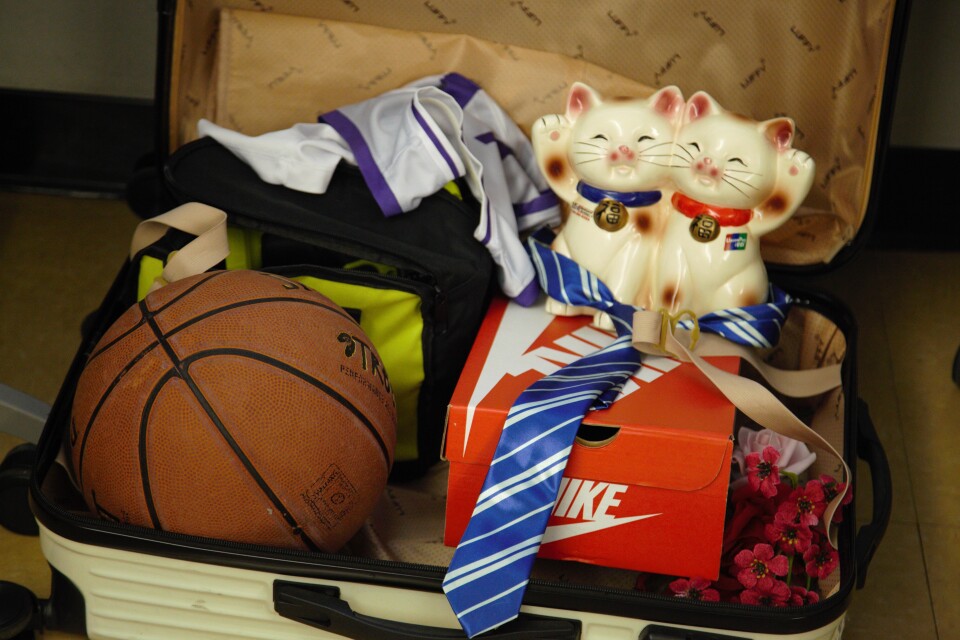Truth matters. Community matters. Your support makes both possible. LAist is one of the few places where news remains independent and free from political and corporate influence. Stand up for truth and for LAist. Make your tax-deductible donation now.
Still Relevant: English Learners Show And Tell In The Classroom

Wendy Tang pauses while presenting in front of class. It’s not an easy feat for anyone to speak in front of nearly 20 peers, even harder for someone whose primary language isn’t English. She laughs from embarrassment and discloses that she’s nervous.
Inspired by the “cajita” project, students have filled “sacred boxes” with significant personal belongings and artifacts that honor family struggles and triumphs.
This is the end of the unit on identity for the lowest credit language class for English learners at Mt. San Antonio College (Mt. SAC). These kinds of classes are meaningful for the students enrolled in them. They’re also in decline, as transfer reforms and other factors shape community college course offerings.
Giving voice to past and present
Tang moved from China to the U.S. on her own. Sharing various items with the class, she points to a small glass bottle containing blades of grass that she’s chosen to represent herself.
“I feel grass is the strongest plant because it doesn’t matter where you put the seeds. It doesn’t matter if there’s a lot of rain,” Tang said. “You just give them a little bit of sunshine and they will grow everywhere. Like the grass, you put me here, I can grow. You put me in another place and I can grow too.”
Students chose items to represent their past cultures, their adjustment to the U.S., and their futures. This project modeled sentipensante — a sensing, thinking approach to learning, professor and chair of Mt. SAC’s American Language program Elizabeth Casian said.
Their boxes are also informed by a True Colors personality test, which Casian uses to help students find more congruence between their values and lives.
Coming to the U.S. from another country is a chance to redirect one’s course, Casian said; immigrants who may have come from more collectivist cultures may not have pursued their individual dreams before, a defining characteristic of American culture.
A former student from Hong Kong told Casian that taking the personality test changed her life when she realized she was in the wrong career — banking. After getting encouragement from Casian, the student embarked on a career change.
Moving between countries and cultures
Through thoughtfully chosen objects, students shared a longing for family and friends, challenges they’ve faced, and changes in perspective. One student shared a picture from his brother’s birthday of them eating hot pot together, a reminder of his Chinese culture. Deanna Contreras brought a baseball hat from the Carl’s Jr. fast food restaurant chain. It represented her growing pains upon coming to the United States from Mexico.
“It was my first job here in the U.S.,” Contreras said. “It was really difficult because I was still learning. I didn’t know any English and a lot of people were mean.”
Referring to a U.S. dollar bill, the student Tang said that money has represented both her Chinese and American cultures. Her relationship toward money has changed. Once seen as an end in itself, she now sees money as a means for having life experiences.

“After coming to America, I tried to find life’s meaning. What’s the meaning for my life? Making money to buy a house — is that happy? Or is it making money so that I can go travel? The world is so big,” Tang said.
Another student from China, Wayne Wang, had a different perspective on money.
“My favorite perfume — Chanel!” Wang said, presenting the bottled fragrance to his class. Unabashedly laughing, he said it represents luxury and his love of money and beauty.
Across California, advancing in English more quickly
Changes to English-as-a-second-language (ESL) credit courses have been underway since the implementation of Assembly Bill 705, which nominally took effect in January 2018 and aimed to get community college students to higher levels of math and English more quickly. For example, English-learners who graduated from high school in the U.S. who may have otherwise placed in a lower level of English in the ESL program now start at a higher level of college composition.
Noncredit, Credit, and Transfer-level Classes at Community College
English as a Second Language (ESL) classes at community colleges are available at the noncredit and credit level. A number of community colleges also offer credit level English second language classes that are transfer-level.
Noncredit level: Classes that are the noncredit level are mainly for precollegiate or adult education purposes. Noncredit level classes can include workforce preparation, parenting education, and some ESL, among other subjects; however, noncredit subjects can also be available for credit. Noncredit level classes have certain characteristics, where depending on the class, students may join or leave the class at any time during the term, there is typically no limit to the number of times a student can take the same class, and there are no enrollment fees, among other things.
Credit level: Most community college classes in academic and vocational subjects are credit level and serve the purpose of students earning an associate degree.
Transfer-level classes are credit level, but not all credit level classes are transfer-level. Transfer-level classes are those that satisfy general education requirements for transfer to a UC or CSU, such as a college composition English class.
“It's now that we have to meet students where they are, whereas before, if you don't have these skills, then you need to get these skills in these lower level classes,” Casian said. “The reason why they pushed AB 705 through in the first place was that the more levels a student has to take, the more chances we have of losing them from college.”
Findings from a 2022 report by the Public Policy Institute of California on the early effect of AB 705 on credit-level English Second Language showed that colleges have been shortening ESL course sequences. Prior to the law, some colleges offered course sequences with as many as six levels or more. According to PPIC, in 2021, over half of colleges offered sequences of four levels or less, compared to just one-third in 2016.
Another consequence of AB 705 includes a decline in student enrollment at Mt. SAC’s American Language Program, according to Casian, who suggested that students may bypass the program for the English department. Casian said the COVID-19 pandemic and travel restrictions also contributed to the decline. Based on data provided by Mt. SAC, student enrollment for credit-level courses in the American Language Program declined substantially, from nearly 1,400 in 2018-2019 to less than half (just over 600) in 2022-2023. (Students may be counted more than once if enrolled in more than one course.)
One concern of the effect of AB 705 is placing students in classes before they’re ready. While getting English learners to higher levels faster is beneficial, Casian said there is still value in offering lower-level credit ESL courses where students can build foundational skills.

“I think that's a testament to what is still needed,” said Casian, who pointed out that while recent legislation asserts all students have a right to take transfer-level courses, not everyone should start there.
Referring to her class, she said, “If you can imagine these students in English 1A [a freshman composition transfer-level class] with the skills that they have, that's not equitable. So that's why we're still here. We're here to provide equity. We're here to provide that support to get students from where they are, to that next level where they need to.”
Second chances and wanting to connect
Damayanthi Jesudason moved to the U.S. in 1996 in response to the Sri Lankan civil war. Over the years, Jesudason said she has not passed a number of English learner classes due to difficulty writing essays and understanding grammar. She said she was also identified as having a learning disability.
Her English language level has affected her regular interactions with others.
“Even when I say ‘vaccine’ at the pharmacy, they don't understand,” she said. “So it was really frustrating me, making me sad because the other person cannot understand my pronunciation. So I thought of coming to class. In that way, I can learn.”
Taking this class has been a way to improve and get closer to her goal of working with animals as a pet groomer. Jesudason recites the maxim “practice makes perfect.”
Another student who goes by the name Ryder Freeman has found it to be a safe haven, a place to make friends. Freeman moved to the U.S. in 2022 and said he is a political refugee from China.
Before taking this class, Freeman stayed home and didn’t know that many people.
“After I took this class, I met my classmates and made friends with them,” he said. “That's a big change to my life.”










